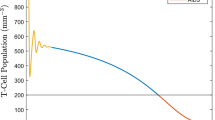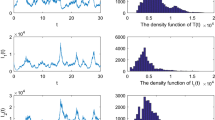Abstract
Highly active antiretroviral therapy can effectively control HIV replication in infected individuals. Some clinical and modeling studies suggested that viral decay dynamics may depend on the inhibited stages of the viral replication cycle. In this paper, we develop a general mathematical model incorporating multiple infection stages and various drug classes that can interfere with specific stages of the viral life cycle. We derive the basic reproductive number and obtain the global stability results of steady states. Using several simple cases of the general model, we study the effect of various drug classes on the dynamics of HIV decay. When drugs are assumed to be 100 % effective, drugs acting later in the viral life cycle lead to a faster or more rapid decay in viremia. This is consistent with some patient and experimental data, and also agrees with previous modeling results. When drugs are not 100 % effective, the viral decay dynamics are more complicated. Without a second population of long-lived infected cells, the viral load decline can have two phases if drugs act at an intermediate stage of the viral replication cycle. The slopes of viral load decline depend on the drug effectiveness, the death rate of infected cells at different stages, and the transition rate of infected cells from one to the next stage. With a second population of long-lived infected cells, the viral load decline can have three distinct phases, consistent with the observation in patients receiving antiretroviral therapy containing the integrase inhibitor raltegravir. We also fit modeling prediction to patient data under efavirenz (a nonnucleoside reverse-transcriptase inhibitor) and raltegravir treatment. The first-phase viral load decline under raltegravir therapy is longer than that under efavirenz, resulting in a lower viral load at initiation of the second-phase decline in patients taking raltegravir. This explains why patients taking a raltegravir-based therapy were faster to achieve viral suppression than those taking an efavirenz-based therapy. Taken together, this work provides a quantitative and systematic comparison of the effect of different drug classes on HIV decay dynamics and can explain the viral load decline in HIV patients treated with raltegravir-containing regimens.







Similar content being viewed by others
References
Andrade A, Guedj J, Rosenkranz SL et al (2015) Early HIV RNA decay during raltegravir-containing regimens exhibits two distinct subphases (1a and 1b). AIDS 29(18):2419–2426
Andrade A, Rosenkranz SL, Cillo AR et al (2013) Three distinct phases of HIV-1 RNA decay in treatment-naive patients receiving raltegravir-based antiretroviral therapy: ACTG A5248. J Infect Dis 208(6):884–891
Browne CJ, Pilyugin SS (2012) Periodic multidrug therapy in a within-host virus model. Bull Math Biol 74:562–589
Donahue DA, Sloan RD, Kuhl BD, Bar-Magen T et al (2010) Stage-dependent inhibition of HIV-1 replication by antiretroviral drugs in cell culture. Antimicrob Agents Chemother 54:1047–1054
Gottlieb MS, Schroff R, Schanker HM, Weisman JD, Fan PT et al (1981) Pneumocystis carinii pneumonia and mucosal candidiasis in previously healthy homosexual men: evidence of a new acquired cellular immunodeficiency. N Engl J Med 305:1425–1431
Gallo RC, Sarinm PS, Gelmann EP, Robertguroff M, Richardson E et al (1983) Isolation of human T-cell leukemia virus in acquired immune deficiency syndrome (AIDS). Science 220:865–867
Gumel AB, McCluskey CC, van den Driessche P (2006) Mathematical study of a staged-progression HIV model with imperfect vaccine. Bull Math Biol 68:2105–2128
Gilmore JB, Kelleher AD, Cooper DA et al (2013) Explaining the determinants of first phase HIV decay dynamics through the effects of stage-dependent drug action. PLoS Comput Biol 9:e1002971
Hollingsworth T, Anderson R, Fraser C (2008) HIV-1 transmission, by stage of infection. J Infect Dis 198:687–693
Hyman JM, Li J (2005) The reproductive number for an HIV model with differential infectivity and staged progression. Linear Algebra Appl 398:101–116
Hyman JM, Li J, Stanley EA (1999) The differential infectivity and staged progression models for the transmission of HIV. Math Biosci 155:77–109
Huang G, Takeuchi Y, Ma W (2010) Lyapunov functionals for delay differential equations model of viral infections. SIAM J Appl Math 70(7):2693–2708
Hale J, Verduyn Lunel SM (1993) Introduction to functional differential equations. Appl Math Sci, vol 99. Springer-Verlag, New York
Lai X, Zou X (2014) Modelling HIV-1 virus dynamics with both virus-to-cell infection and cell-to-cell transmission. SIAM Appl Math 74:898–917
Longini I, Clark W Jr, Haber M et al (1989) The stages of HIV infection: waiting times and infection transmission probabilities. Springer, Berlin Heidelberg
Lloyd AL (2001) The dependence of viral parameter estimates on the assumed viral life cycle: limitations of studies of viral load data. Proc R Soc Lond B Biol Sci 268(1469):847–854
Markowitz M, Nguyen BY, Gotuzzo E et al (2007) Rapid and durable antiretroviral effect of the HIV-1 integrase inhibitor raltegravir as part of combination therapy in treatment-naive patients with HIV-1 infection: results of a 48-week controlled study. JAIDS 46:125–133
Murray JM, Emery S, Kelleher AD et al (2007) Antiretroviral therapy with the integrase inhibitor raltegravir alters decay kinetics of HIV, significantly reducing the second phase. AIDS 21:2315–2321
Murray JM, Kelleher AD, Cooper DA (2011) Timing of the components of the HIV life cycle in productively infected CD4+ T cells in a population of HIV-infected individuals. J Virol 85:10798–10805
Nelson PW, Murray JD, Perelson AS (2000) A model of HIV-1 pathogenesis that includes an intracellular delay. Math Biosci 163:201–215
Nelson PW, Perelson AS (2002) Mathematical analysis of delay differential equation models of HIV-1 infection. Math Biosci 179:73–94
Perelson AS, Nelson PW (1999) Mathematical analysis of HIV-1 dynamics in vivo. SIAM Rev 41:3–44
Perelson AS et al (1997) Decay characteristics of HIV-1-infected compartments during combination therapy. Nature 387:188–191
Perelson AS, Ribeiro RM (2013) Modeling the within-host dynamics of HIV infection. BMC Biol 11:96–105
Rong L, Gilchrist MA, Feng Z et al (2007a) Modeling within-host HIV-1 dynamics and the evolution of drug resistance: trade-offs between viral enzyme function and drug susceptibility. J Theor Biol 247:804–818
Rong L, Feng Z, Perelson AS (2007b) Mathematical analysis of age-structured HIV-1 dynamics with combination antiretroviral therapy. SIAM Appl Math 67:731–756
Rong L, Feng Z, Perelson AS (2007c) Emergence of HIV-1 drug resistance during antiretroviral treatment. Bull Math Biol 69:2027–2060
Rong L, Perelson AS (2009a) Modeling HIV persistence, the latent reservoir, and viral blips. J Theor Biol 260:308–331
Rong L, Perelson AS (2009b) Modeling latently infected cell activation: viral and latent reservoir persistence, and viral blips in HIV-infected patients on potent therapy. PLoS Comput Biol 5(10):e1000533
Rong L, Perelson AS (2009c) Asymmetric division of activated latently infected cells may explain the decay kinetics of the HIV-1 latent reservoir and intermittent viral blips. Math Biosci 217:77–87
Sedaghat AR, Dinoso JB, Shen L, Wilke CO, Siliciano RF (2008) Decay dynamics of HIV-1 depend on the inhibited stages of the viral life cycle. Proc Natl Acad Sci USA 105:4832–4837
Sedaghat AR, Siliciano RF, Wilke CO (2009) Constraints on the dominant mechanism for HIV viral dynamics in patients on raltegravir. Antivir Ther 14:263–271
Shen L, Peterson S, Sedaghat AR et al (2008) Dose-response curve slope sets class-specific limits on inhibitory potential of anti-HIV drugs. Nat Med 14:762–766
Vaidya NK, Rong L, Marconi VC et al (2010) Treatment-mediated alterations in HIV fitness preserve CD4+ T cell counts but have minimal effects on viral load. PLoS Comput Biol 6(11):e1001012
van den Driessche P, Watmough J (2002) Reproduction numbers and sub-threshold endemic equilibria for compartmental models of disease transmission. Math Biosci 180:29–48
von Kleist M, Menz S, Huisinga W (2010) Drug-class specific impact of antivirals on the reproductive capacity of HIV. PLoS Comput Biol 6:e1000720
Wodarz D, Nelson PW (2002) Mathematical models of HIV pathogenesis and treatment. BioEssays 24:1178–1187
Wang X, Tao Y (2008) Lyapunov function and global properties of virus dynamics with CTL immune response. Int J Biomath 1:443–448
Wang X, Elaiw AM, Song X (2012) Global properties of a delayed HIV infection model with CTL immune response. Appl Math Comput 218:9405–9414
Wang X, Liu S (2012) Global properties of a delayed SIR epidemic model with multiple parallel infectious stages. Math Biosci Eng 9:685–695
Wang X, Liu S (2013) A class of delayed viral models with saturation infection rate and immune response. Math Method Appl Sci 36:125–142
Wang X, Liu S, Rong L (2014) Permanence and extinction of a non-autonomous HIV-1 model with two time delays. Discrete Cont Dyn Syst B 19:1783–1800
Wang S, Rong L (2014) Stochastic population switch may explain the latent reservoir stability and intermittent viral blips in HIV patients on suppressive therapy. J Theor Biol 360:137–148
Wang S, Hottz P, Schechter M, Rong L (2015) Modeling the slow CD4+ T cell decline in HIV-infected individuals. PLoS Comput Biol 11(12):e1004665
Wawer M, Gray R, Sewankambo N et al (2005) Rates of HIV-1 transmission per coital act, by stage of HIV-1 infection, in Rakai. Uganda J Infect Dis 191:1403–1409
Wei X et al (1995) Viral dynamics in human immunodeficiency virus type 1 infection. Nature 373:117–122
World Health Organization (2014) Global health observatory (GHO): HIV/AIDS. http://www.who.int/gho/hiv/en/. Accessed Dec 2014
Acknowledgments
This work was finished when XW visited Oakland University in 2015. XW is supported by the Nanhu Scholar Program for Young Scholars of XYNU, the NNSF of China (No.11301453), Postdoctoral Science Foundation of China (2014M562366), Postdoctoral Science Foundation of Shaanxi Province (2014010), the Universities Young Teachers Program of Henan Province (2014GGJS-093), and Doctoral Scientific Research Startup Fund of Xinyang Normal University (2014). LR is supported by NSF Grants DMS-1122290 and DMS-1349939.
Author information
Authors and Affiliations
Corresponding author
Appendix
Appendix
We prove the global stability of steady states of the general multi-stage model (Eq. 1). Inspired by the results in Huang et al. (2010), we define a Lyapunov function \(L_0=L_0(x,y_1,y_2,\ldots ,y_n,v)\) as follows
Calculating the derivative of \(L_0\) along the positive solution of system (1) and using \(\lambda =\mu x_0\), \(R_0\le 1\), we have
\(\dot{L}_0\Big |_{(1)}=0\) if and only if \(v(t)=0\) (or \(R_0= 1\)) and \(x=x_0\). Therefore, the maximal compact invariant set in \(\{\dot{L}_0\Big |_{(1)}=0\}\) is the singleton \(\{E_0\}\). The global asymptotical stability of the infection-free steady state \(E_0\) follows from LaSalle Invariance Principle (Hale et al. 1993).
To prove the global stability of the infected steady state, we define the Lyapunov function \(L_1=L_1(x,y_1,y_2,\ldots ,y_n,v)\) as follows
Calculating the derivative of \(L_1\) along the positive solution of system (1), we obtain
From the infected steady state, we have
Therefore, we have
The last inequality follows from the fact that the arithmetic mean is always greater than or equal to the geometric mean, i.e.,
\(\dot{L}_1\Big |_{(1)}=0\) if and only if \(x=x^*\) and the left side of the above inequality is equal to \(n+2\), i.e.,
From Eq. (21), we have \(v=v^*\) and \(y_i=y_i^*\), \(i=1,2,\cdots ,n\). Therefore, we conclude that \(\dot{L}_1\Big |_{(1)}\le 0\) holds for all \(x,y_i,v>0\). The maximal compact invariant set in \(\{\dot{L}_1\Big |_{(1)}=0\}\) is the singleton \(\{E^{*}\}\). We finish the proof of the global asymptotical attractivity of the infected steady state \(E^{*}\).
Rights and permissions
About this article
Cite this article
Wang, X., Song, X., Tang, S. et al. Dynamics of an HIV Model with Multiple Infection Stages and Treatment with Different Drug Classes. Bull Math Biol 78, 322–349 (2016). https://doi.org/10.1007/s11538-016-0145-5
Received:
Accepted:
Published:
Issue Date:
DOI: https://doi.org/10.1007/s11538-016-0145-5




